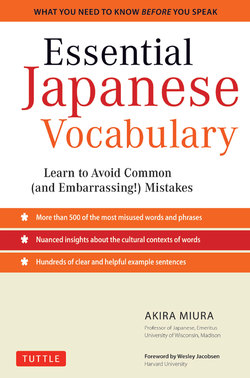Читать книгу Essential Japanese Vocabulary - Akira Miura - Страница 8
На сайте Литреса книга снята с продажи.
ОглавлениеExplanatory Notes
ARRANGEMENT OF ENTRIES
The main text of this book consists of a list of more than 500 Japanese terms. Each entry heading gives the term in romanization and in Japanese kanji (ideographic characters) and/ or kana (syllabics), then one or more English “equivalents.” The kanji are limited to those widely in use. The heading is then followed by a detailed explanation of the term’s usage.
TERMINOLOGY
Since this book is meant not as a scholarly treatise but rather as a reference book for elementary- through intermediate-level students, the number of technical terms has been kept to a minimum.
I -Adjectives. These adjectives are inflected words that end in -ai, -ii, -ui, or -oi. Hayai 速い “fast,” ōkii 大きい “large,” furui 古い “old,” and hiroi 広い “wide,” for example, are i-adjectives. The -ku form of an adjective (e.g., hayaku) is referred to as the adverbial form.
Na-Adjectives. Na-adjectives are so called because when they are used to modify a noun, they require na な, as in kirei na hana きれいな花 “a beautiful flower” or iya na hito いやな人 “a nasty person.” Na-adjectives are sometimes called na-nouns by other authors for they behave like a noun in that they may occur with desu to form complete sentences. Other examples of na-adjectives are genki 元気 “healthy” and shitsurei 失礼 “rude.”
Nouns. Japanese nouns are noninflected words that can occur before desu to constitute complete utterances. Hon “book,” eiga “movie,” and gaijin “foreigner,” are nouns.
Particles. Japanese particles are uninflected words that occur within or at the end of a sentence. They generally do not begin an utterance. When they occur within a sentence, they relate what precedes (whether a word, a phrase, or a clause) to what follows. (For this reason, particles are sometimes called relationals.) Examples of this type are wa は, ga が, o を, and to と. Particles that occur at the end of a sentence are called sentence-final particles, and they make the sentence interrogative, exclamatory, emphatic, etc. Examples of this type are ka か, nē ねえ, and yo よ.
Verbs. Japanese verbs are inflected words that take -masu in the formal nonpast and -mashita in the formal past. Iku “to go,” kuru “to come,” and taberu “to eat,” for example, are verbs.
Potential forms of verbs. Potential forms are forms that mean “can do such and such” or “such and such can be done.” Yomeru 読める, for example, is the potential form of yomu 読む “to read” and means “can read” or “can be read.”
Punctual verbs. Verbs representing actions or occurrences that take place without duration over time are punctual verbs. Shinu 死ぬ “to die,” tsuku 着く “to arrive” and kekkon-suru 結婚する “to get married” are examples of this type.
Stative verbs. Verbs that express states rather than actions are stative verbs. Iru いる “(someone) is (somewhere)” and aru ある “(something) is (somewhere)” are examples of this category.
JAPANESE ACCENT
Accent marks are used in this book. They are, as a rule, used in the entry headings only, e.g., ŌKII.
Unlike English, which has a stress accent, Japanese has a pitch accent. In Japanese words, each syllable is spoken either high or low. If the first syllable is low, the second is always high, and if the first syllable is high, the second is always low. In this book, the mark “” indicates a rise in pitch, and the mark “” indicates a fall in pitch. The syllable followed by “” is always the accented syllable. For example, ŌKII, a four-syllable word, should be pronounced low-high-high-low, and KI, the last syllable before the fall, is the accented syllable. Some words are left completely unmarked, e.g., KIMONO. Unmarked words are accentless (or unaccented) words, i.e., words that do not have a fall in pitch. In accentless words, the first syllable is always low, but the remaining syllables are all high, and there is no fall in pitch even when the words are followed by a particle. For example, kimono wa is pronounced:
ki mono wa
Words that end with an accented syllable (e.g., ATAMA) have the same accent pattern as accentless words when pronounced by themselves, but when they are followed by a particle, a difference emerges. For example, ATAMA (accented) and KIMONO (accentless) have exactly the same pitch pattern when pronounced alone, but when followed by a particle (e.g., wa) they are pronounced differently, as follows:
atama wa → a tama wa
kimono wa → ki mono wa
Note that wa in atama wa is low while wa in kimono wa is high.
ROMANIZATION
The system of romanization used in this book is the popular Hepburn system. There are, however, some differences that should be mentioned. In this book, ん is always written n, even before m, p, and b. When n should be pronounced independently of a vowel or y that follows it, an apostrophe is inserted to indicate the fact. Long vowels are generally shown with macrons. Long vowels, however, are not indicated in the proper names that appear in the bibliography.
OTHER CONVENTIONS
An asterisk is used in this book to mark incorrect utterances. A question mark at the beginning of a sentence indicates unnaturalness or awkwardness.
